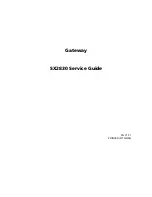
17
ASUS WLAN mini-PCI card
Reference
Chapter 3
SSID
Use the SSID filed to configure the SSID for the ASUS
WLAN mini-PCI
card
. You can enter a new SSID or select one from the drop-down list box.
SSID stands for “Service Set Identifier”, which is a string used to identify a
wireless LAN. You will only be able to connect Access Points which has the
same SSID as the one you set. Use different SSIDs to segment the wireless
LAN and increase security. SSIDs must all be printable characters and hav-
ing a maximum of 32 case sensitive characters, such as “ Wireless LAN”.
Set the SSID to “any” if you wish to allow your station to connect to
any IEEE 802.11 Infrastructure Network it can find. When you set to
“any”, “Scanning...” will begin and may take a long time. Use “Sur-
vey” to view all Access Points within range and their SSIDs.
Channel
Using the Channel field to select the radio channel for ASUS
WLAN mini-PCI
card
. In an “infrastructure” network, your PC Card will automatically se-
lect the correct frequency channel required to communicate with an Access
Point, this parameter will be fixed in “Auto” and cannot be changed. In an
“Ad Hoc” network, you can decide the channel number for the ASUS
WLAN
mini-PCI card
. Any ASUS
WLAN mini-PCI card
can communicate in
the same network if each has the same frequency channel setting. The radio
channels you may use depend on the regulations in your country. For United
States (FCC) and Canada (IC), channels 1 to 11 are supported. For Europe
(ETSI) except Spain and France, channels 1 to 13 are supported. For Spain
channel 10 and 11 are supported. For France, channels 10 to 13 are sup-
ported. For operation in Japan (MKK), channels 1 to 14 are supported.
Data Rate
Fully Auto – Automatic transmit data rate falls back to 1, 2, 5.5, or 11
megabits per second when necessary to maintain transfers with devices.
Auto 1 or 2 Mbps – The PC Card will adjust to the most suitable trans-
mission rate. The transmit data rate is either 1 Mbps or 2 Mbps.
11 Mbps – Fix data rate to 11 megabits per second.
5.5 Mbps – Fix data rate to 5.5 megabits per second.
2 Mbps – Fix data rate to 2 megabits per second.
1 Mbps – Fix data rate to 1 megabits per second.
















































